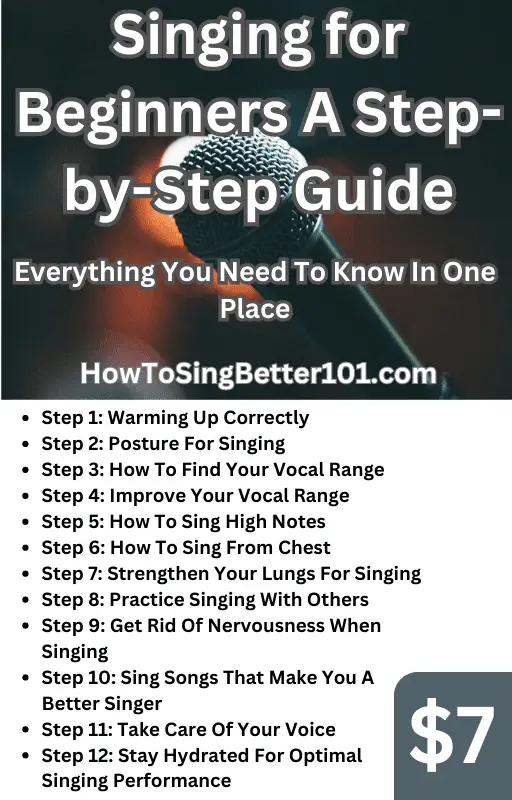There are a lot of people confused about the vocal range and falsetto, mainly if it is part of the vocal range or not. If you made a couple of searches online on the topic at hand you are probably even more confused than before.
In classical vocal tradition, falsetto is typically not considered as a part of the vocal range for anyone other than countertenors. Countertenors specialize in utilizing falsetto to achieve higher registers. However, there are exceptions to this rule, such as the baryton-Martin vocal technique, which incorporates falsetto into its repertoire. While falsetto may not be widely recognized within classical purism, its usage can vary depending on specific vocal techniques and styles.
If you want to enhance your singing and speaking voice then my personal recommendation is to use a natural vocal booster that also soothes and relieves hoarseness Click here to check it out on Amazon.com
Simply put, if you can sing falsetto and make it sound natural and unforced then you should include it in your vocal range, if not then you should not include it in your vocal range. A lot of singers when they go to an audition will put their falsetto voice also in their vocal range on their resume. Most of these singers look at the vocal range of famous singers and they think that the higher their vocal range is the better their chances of getting the audition.
While these larger vocal ranges do look impressive on the resume, the problem is when the singer actually starts to sing and it will be extremely noticeable that they not only force their falsetto because they can not use their head voice but also that their falsetto sounds bad and forced in most cases. Having a wide vocal range does look and sound impressive only if you can actually sing it if you include in your resume your falsetto in your vocal range and you can not sing it correctly then you set yourself up for a big disappointment.
My personal recommendation is to be honest with yourself if you know that your falsetto singing is forced then do not include it in your vocal range, this way nobody will actually expect you to sing higher vocal ranges. What you need to understand as a singer is not to complicate your life by trying to achieve a higher vocal range, especially if you can not use your head voice correctly. The vocal range chart is a guide for singers who want to know approximately what their vocal range is and nothing else.
Most beginner singers are extremely confused about their vocal range, and who can blame them. The definition of different vocal ranges contradicts each other fairly regularly and oftentimes it remains to the singer to try and figure it out. The same tends to happen if you get lessons from several vocal coaches, some will say your vocal range includes falsetto, while others will say that it doesn’t include your falsetto voice.
The main problem is that most people confuse the head voice with falsetto, and you will have to have a good listening ear to know which one is being used if you are not the person who is actually singing. Even if you are singing a song that needs you to use your head voice, you might use your falsetto voice without even noticing. If you have read my recent article How to switch from chest voice to head voice? ( 7 Easy Ways ), you probably know that there is a lot of confusion around transitioning between your different voices, and some might even say that if you are using your falsetto voice then you are doing it wrong.
A lot of singers consider falsetto as fake singing, this is also the meaning of the word “falsetto” which translates to faking it. There are some singers who can actually sing well with their falsetto voice to the point where the listeners will actually think they are using their head voice. The problem is that singers who dislike the falsetto have good reasons for doing it, singing falsetto is one of the hardest and most unnatural ways to sing which often could lead down the path of injury.
Most singer’s worst nightmare is to have vocal nodules, the problem with falsetto is that using your falsetto voice will actually cause vocal nodules in the long run. The main problem why some singers do rely on falsetto to sing is due to bad habits, singing high notes with the head voice is fairly hard, and once they notice that they can sing the high notes with falsetto they will simply stick with it, in some cases they do not even know they are suing falsetto.
Does Vocal Range Include Falsetto?
No, vocal range typically does not include falsetto. Falsetto is a vocal register characterized by a lighter and breathier quality, often associated with singing higher pitches. It is commonly utilized by male singers, but can also be accessed by female singers. Vocal range refers to the span of notes a singer can comfortably and confidently sing across different registers, including chest voice, head voice, and falsetto. While falsetto may have a different timbre and production technique compared to other registers, it can still contribute to a singer’s overall vocal range.
Earn a 50% Commission on each sale by simply sharing my guides with friends and family on social media, check out How To Sing Better 101 Affiliates
Does Vocal Range Include Head Voice And Falsetto?
When answering the question if your vocal range does include falsetto, first you have to know what the head voice is and if this is included in the vocal range. Yes, the vocal range does include the head voice, the problem is that most singers do not know how to sing from their head voice and this is why their own vocal range doesn’t include it. In some cases, their vocal range is so narrow that they simply can not sing with head voice or even with falsetto, in this case, the head voice is not included in their vocal range.
If you are a beginner singer, my recommendation is to make a vocal range test, you can find a lot of apps or online sites that will offer you some insight into your true vocal range. The problem with most of them is that they can not make the difference between head voice and falsetto. In addition to this, you can take some quizzes also, just type in Google “what is my vocal range quiz” and you will see plenty of websites, although my recommendation is to stick with websites that are oriented towards singers and not some generic quiz site.
You can also view a vocal range chart, to find what your average vocal range should be. If you are a male singer and you want to find out more about your vocal range, then check out my recent article What is the average vocal range male? ( Range, Scale and Chart ).
Famous Singers With A Falsetto Voice
If you are listening to modern music then you might be thinking that most of the singers are using their head voice, instead of falsetto, and you are probably thinking this because there is so much more information about this topic readily available to anybody who would want to learn to sing. The truth is that some of the most popular modern singers actually use falsetto, and yes their falsetto voice is included in their vocal range as they are using it intentionally.
Some good examples of falsetto singers are Maroon 5, The Darkness, Ed Sheeran, and even Guns N’ Roses. If you follow any of these singers or their bands on social media you might have noticed that these singers have throat surgery once every couple of years, and this is due to them using falsetto.
Key Takeaways
- No, falsetto is not included in the vocal range but some singers do include falsetto in their vocal range in order to have a more impressive vocal range. Generally speaking, singers who can pull off singing falsetto tend to include it in their vocal range. On the other hand, singers who can not sing falsetto will not include it in their vocal range.
- When discussing vocal range, it is common to refer to the different registers within the range, including chest voice, head voice, and falsetto. Each register represents a distinct set of vocal characteristics and capabilities.
- Some singers may have a wider range that includes a strong and well-developed falsetto, while others may have a more limited range or struggle to access their falsetto.
FAQ
Why is falsetto not part of vocal range?
Falsetto is a vocal register that occurs when the vocal folds are thin and only the edges vibrate. It is considered separate from the full vocal range because it has a different quality and lacks the fullness and power of the chest or head voice.
What part of your range is falsetto?
Falsetto typically encompasses the higher end of a person’s vocal range, often extending into the upper registers beyond the comfortable range of the modal or chest voice.
Does head voice count for vocal range?
Yes, head voice is a legitimate part of a singer’s vocal range. It refers to the higher register produced with resonance in the head and a lighter quality compared to the chest voice.
What are the vocal range counts?
Vocal range is typically expressed in terms of octaves. It represents the span of notes a singer can comfortably and confidently produce, from the lowest to the highest. The specific count of octaves can vary widely among singers, with some having a range of 2 to 4 octaves or more.

